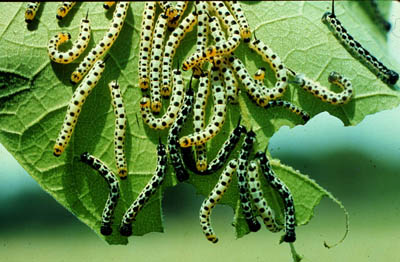

Materials:
Catalpa caterpillars , caterpillar pictures, pictures of a variety of insects, pencil and paper
Background Information:
Catalpa Sphinx Moth Caterpillars live on the Catalpa tree. The caterpillar is an insect. It has real legs and prolegs help it hang onto the tree.
Purpose:
Students will observe the caterpillars and locate body parts. Students will see that the caterpillar has special body part for living on the tree such as sucker-like prolegs to help hold on and chewing mouth parts for eating leaves. Students will also observe the 5 different instar stages of the Catalpa caterpillar. Students will use magnifying glasses to do their observations and sketch the caterpillar .
Step One:
If you don't have a Catalpa tree nearby that students can observe, collect a few caterpillars from Catalpa trees and set up a Catalpa terrarium to allow students to observe. It is best to have about 5 caterpillars at different stages of development with an adequate supply of catalpa leaves. The caterpillars are voracious eaters. A branch of a Catalpa tree can be put into a quart jar of water inside a10 gallon aquarium with a lid . Show students how they cling to the leaves and allow them to actually hold them. Advise them to handle the caterpillars with care. Allow them to observe them close up with a magnifying glass; especially their mouth parts and legs. If you have access to a flex-cam microscope with a monitor, use it to show them close up observations of the caterpillar.
Step Two:
Explain to students that the caterpillars are insects and have 3 pair of legs near their head region and fake legs called prolegs that work like suckers to hold them to the leaves. Ask students to decide from their observations if the caterpillar has sucking or chewing mouth parts. Show them some chewed leaves. Caterpillars have segmented or divided bodies usually divided into 12 parts or sections. Begin to introduce the idea that the caterpillar will change the way they look and develop to become a moth.
Step Three:
Ask students to observe their caterpillars and draw and color a diagram to match the caterpillars as close as they can. You may want them to label the eyes, legs and prolegs. Ask students for ideas on why the caterpillars are colored the way they are. Explain to them the idea of camouflage or blending in or coloring to look scary or like they taste bad to a predator.
Step Four:
Ask students for ideas on how the way their caterpillar looks would change if it lived some where else. Give them several examples of different habitats or types of plants and ask them to describe how a caterpillar would look.
| Discover Life | Education | Training Guides and Protocol s | Habitat Adaptations |